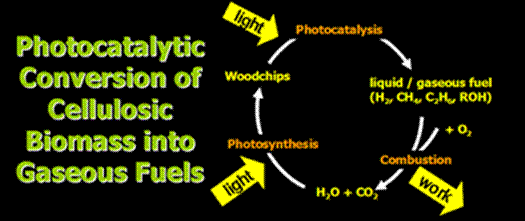AmericanChemicalSociety.com
Reports: ND10 48766-ND10: Photocatalytic Conversion of Cellulosic Biomass into Gaseous Fuels
Frank E. Osterloh, University of California (Davis)
<>Project Goals
The goal of this project is to test and develop novel
materials for photocatalytic conversion of cellulosic biomass into gaseous
fuels. This reaction converts abundant photochemical energy (sunlight) and
residues from the forest and food industries (wheat straw and wood chips) into
usable fuels, incl. hydrogen, and potentially methane and ethane.
<>Impact of Research
Work Tasks Completed: Cuprous oxide (Cu2O) nanocrystals,
cupric oxide (CuO) nanocrystals, vanadium oxide (V2O5)
nanoribbons, and copper selenide (CuSe) nanocrystals were synthesized and
tested for photocatalytic activity, using methanol as a cellulose model.
Results: 1. Neither Cu2O nanocrystals or
CuO nanocrystals were found to have photocatalytic activity for methanol
conversion. 2. Visible illumination (l>400 nm) in aqueous methanol solution
photoconverts a red V2O5 gel into a green VO2
gel. The process is accompanied by a shift of the absorption onset from 612 nm
(Eg=2.03eV) to 486 nm (Eg=2.55eV), consistent with the bandgaps of the two
materials. High resolution TEMs and selective area electron diffraction (SAED)
data show that the crystalline structure of the V2O5 gel
is retained upon reduction. Under visible irradiation (l>400 nm) VO2 produces small quantities of hydrogen from aqueous solutions of glucose. After attachment of colloidal Pt
nanoparticles, H2 evolution proceeds catalytically with a quantum
efficiency of 1.00-1.69% (at 440 nm). The higher activity of VO2-Pt
is due to the reduction of the H2 evolution overpotential from
-1.064V to -0.979V. From the photocurrent onset potential, the VO2
conduction band edge is located at –0.12 V (NHE) at pH=3, just below the proton
reduction potential. One manuscript is in preparation. 3. CuSe nanocrystals were found to evolve H2
from aqueous methanol when irradiated with UV light. The potential of this
material is being evaluated.
<>Impact on Career
1. I presented the results on VO2 at the Fall
2010 ACS meeting in Boston, as part of a talk entitled: Making Fuel from
Sunshine: Inorganic Nanomaterials for Photocatalytic Hydrogen Production. 2. I am currently being evaluated for
promotion to full professor. No
publication has resulted from this grant yet.
<>Impact on Students
1. The work on V2O5/VO2 is
part of a dissertation for F. Andrew Frame, who will graduate later this year
with a Ph.D. in chemistry. 2. The work on Cu2Se will be
integrated into the M.S. thesis of Sarah Gee, who will graduate early next year
with a M.S. degree in chemistry.
 <>
<>
Copyright © American Chemical Society

